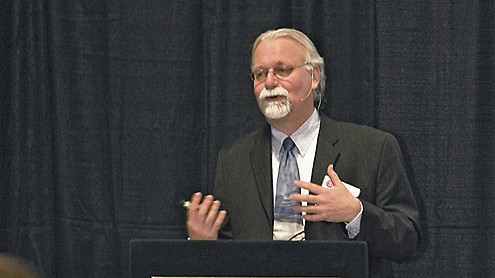Fed economist forecasts 2.5% growth this year

Gary Zimmerman, a senior economist with the Federal Reserve Bank of San Francisco, told a crowd at CSU Channel Islands on Feb. 2 that the Fed expects the nation’s economy to grow by about 2.5 percent this year. (photo courtesy of CSUCI).
A senior economist with the Federal Reserve Bank of San Francisco told a breakfast gathering of the Ventura County banking community Thursday that the Fed expects the nation’s economy to grow by about 2.5 percent this year and 3 percent in 2013 with inflation kept in check.
Gary C. Zimmerman gave a detailed look at what’s ahead for the economy in his appearance at CSU Channel Islands, and he fielded a question from the audience that’s been on the minds of a lot of entrepreneurs: Why are banks sitting on about $1.5 billion in excess reserves while businesses are starved for credit?
Zimmerman responded that, even as the Fed has pumped a lot of money into the financial system, many banks continue to have a high level of bad mortgages and face issues with the quality of their assets as a result of the recession.
“Would more money flowing help? Yes,” he said, “but one of the lessons we learned was at some point you have to make sure that the money is going to be repaid.” He asked how many in the audience remembered the days of NINJA loans (No Income, No Job, No Assets) and said the lesson of subprime lending was that everyone, not just the holders of such loans, was hurt when the housing bubble collapsed.
He said analysis of lending patterns has shown that financial institutions with higher ratings from regulators are actually increasing their lending, while those still constrained by capital requirements and bad loans are not.
In his presentation on the outlook for the economy in 2012 and beyond, Zimmerman said the Fed expects the Gross National Product growth to lumber at 2 percent in the first half of this year before picking up gradually. The Fed expects modest gains in consumer spending for the year, he said, and a strong gain on the investment spending side. He cautioned that the European debt crisis poses a risk of contagion to the banking system worldwide.
Because the recovery from the steepest and most prolonged U.S. recession since the Great Depression will be slow, the Fed does not expect the national unemployment rate to drop to 7 percent until the end of 2014.
“The good news here is we’re growing,” he said. “The bad news is we’re probably not growing as fast as the economy potentially could grow until later in this period.”
A slide in his presentation showed that the U.S. has the capital, factories and labor force to add $800 billion more a year to the Gross National Product, a huge gap in idle economic potential.
Persistent long-term unemployment and slow growth in wages are holding back consumer demand, he said. Even so, consumer confidence appears to be gaining as people get the feeling that the worst is over, he said. He asked members of the audience who thought the economy would get worse this year to raise their hand, and none did so. He said that out of 600 people in his last presentation, only one thought things would get worse.
The housing market continues to be a drag on the economy, even with mortgage rates at all-time lows and with housing affordability jumping to nearly record levels. Recent surveys by Case Schiller and the National Association of Realtors show year-to-year declines in home prices of 2, 3 and 4 percent, he said. But credit standards to obtain residential home loans have tightened considerably, with the median FICO score required for approval jumping from the 740 range to 770 or higher, he said.
The other side of the coin, he said, is that inflation is expected to be at around 1.5 percent in 2012 and 2013.
He said the Fed has done all it can to stimulate the economy in its traditional manner through the federal funds rate, but it is now being more open and transparent about its intentions as a way to guide investors and consumers. Last week, the Federal Reserve announced after its regular meeting that it will continue to hold short-term interest rates to historically low levels through 2014.
Zimmerman said that to provide the needed stimulus to the economy, the Fed would have to set the overnight funds rate at minus 2 to minus 3 percent, which it cannot do. It has instead moved to reduce long-term interest rates by making large scale purchases of mortgage backed securities and long-term Treasury securities. He cited a study that estimated that the Fed’s large-scale asset purchases resulted in a 1.5 percent reduction in the nation’s unemployment rate.
He noted that the Fed’s stimulus policies are adding 1 percent to the U.S. inflation rate. With inflation forecast at 1.5 percent during the next two years, he said inflation would only be at 0.5 percent without the Fed’s stimulus.
A member of the audience asked Zimmerman if the Fed could have dampened the housing bubble in 2000 by raising interest rates. The Fed economist said it is always easier to make policy in hindsight. He said that at that time, the Fed was worried about deflation, and it made sense to act as it did in holding rates down.










